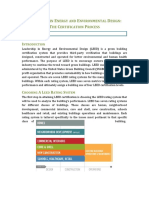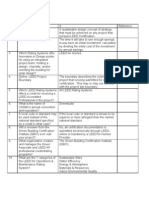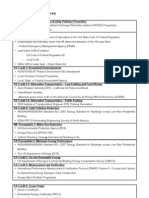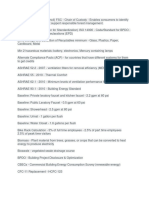LEED Green Building Certification System
Uploaded by
api-27027563LEED Green Building Certification System
Uploaded by
api-27027563LEED Green Building Certification System
What is LEED?
LEED is a third party certification program and the nationally accepted benchmark for the design,
construction and operation of high performance green buildings. Developed by the U.S. Green Building
Council in 2000 through a consensus based process, LEED serves as a tool for buildings of all types and
sizes. LEED certification offers third party validation of a project’s green features and verifies that the
building is operating exactly the way it was designed to.
What types of buildings can use LEED?
LEED certification is available for all building types including new construction and major renovation;
existing buildings; commercial interiors; core and shell; schools and homes. LEED systems for
neighborhood development, retail and healthcare are currently pilot testing. To date, there is over 4.5
billion square feet of construction space involved with the LEED system.
How does LEED work?
LEED is a point based system where building projects earn LEED points for satisfying specific green
building criteria. Within each of the seven LEED credit categories, projects must satisfy particular
prerequisites and earn points.
The five categories include Sustainable Sites (SS), Water Efficiency (WE), Energy and Atmosphere (EA),
Materials and Resources (MR) and Indoor Environmental Quality (IEQ). An additional category,
Innovation in Design (ID), addresses sustainable building expertise as well as design measures not
covered under the five environmental categories. The number of points the project earns determines the
level of LEED Certification the project receives. LEED certification is available in four progressive levels
according to the following scale:
There are 100 base points; 6 possible Innovation in Design and 4 Regional Priority points
Certified 40–49 points
Silver 50–59 points
Gold 60–79 points
Platinum 80 points and above
What are regional credits?
Regional credits are another feature of LEED and acknowledge the importance of local conditions in
determining best environmental design and construction practices. LEED projects will be able to earn
“bonus points” for implementing green building strategies that address the important environmental issues
facing their region. A project can be awarded as many as four extra points, one point each for achieving
up to four of the six priority credits. To download a region-by-region list of priority credits, visit
www.usgbc.org/leedv3.
How are LEED credits weighted?
The allocation of points is based on strategies that will have greater positive impacts on what matters
most – energy efficiency and CO2 reductions. Each credit was evaluated against a list of 13
environmental impact categories, including climate change, indoor environmental quality, resource
depletion and water intake, among many others.
Is LEED training available?
Yes, USGBC offers a variety of LEED instructor-led workshops, online courses and Webinars (live and
on-demand). To learn more about USGBC’s LEED curriculum, visit www.usgbc.org/education.
Can products be certified under LEED?
No, LEED applies to green building projects. Individual products can contribute to points under the
certification system; LEED criteria are performance-based. In attempting to meet these requirements,
LEED practitioners identify products that have desired attributes. However, some LEED criteria do require
specific product data as a part of a successful submittal.
How much does it cost to register a project?
The registration fee for a project is $450 for USGBC members and $600 for nonmembers.
What is the process for LEED certification?
Certification is now administered by the Green Building Certification Institute (GBCI) through a network of
professional, third-party certification bodies. To register a project for LEED certification, visit
www.gbci.org.
What is the average LEED certification fee?
LEED certification fees vary by project size but the average certification cost is $2000.
What is the LEED professional credentialing program?
The LEED professional credentialing program is being managed by GBCI, and includes a multi-faceted
credentialing system that ensures that LEED professionals have the latest knowledge and understanding
of green building practices and to encourage professionals to maintain and advance their knowledge and
expertise.
Under the new program, there are three tiers of excellence for a professional to pursue: LEED Green
Associate; LEED AP with specialty; and LEED AP Fellow. To learn more about the tiers and the
professional credentialing program, visit www.gbci.org.
Does green building cost more?
No, green buildings do not have to cost a penny more. LEED certified projects to date demonstrate that
you can achieve LEED certification and reap its many benefits with a common-sense approach to design
with no additional dollars. Depending on your green building strategy and the level of certification your
project is targeting, there may be mid- and long-term ROI associated with additional green features that
merits an investment in first costs.
What are the benefits of LEED certification?
LEED certification is third-party validation of a building’s performance. LEED certified projects blend
environmental, economic, and occupant-oriented performance. They cost less to operate and maintain;
are energy- and water-efficient; have higher lease-up rates than conventional buildings in their markets;
are healthier and safer for occupants; and are a physical demonstration of the values of the organizations
that own and occupy them. For more information: www.usgbc.org.
You might also like
- Special Design Provisions For Wind and Seismic With Commentary - American Wood Council (AWC) 2021100% (1)Special Design Provisions For Wind and Seismic With Commentary - American Wood Council (AWC) 2021151 pages
- Mathematics Exam Questions For SS1 Third Term100% (5)Mathematics Exam Questions For SS1 Third Term26 pages
- AASHTO RSDG 4 2011 With 2012 & 2015 Errata100% (1)AASHTO RSDG 4 2011 With 2012 & 2015 Errata383 pages
- Leed-Green-Assoc-Leed-V4-Edition-Us-2-Pdf-Free 13No ratings yetLeed-Green-Assoc-Leed-V4-Edition-Us-2-Pdf-Free 131 page
- Commercial Buildings D+C MW Submission Template - Locked-Final - v4.0No ratings yetCommercial Buildings D+C MW Submission Template - Locked-Final - v4.015 pages
- Your Home Technical Manual (4th Edition)No ratings yetYour Home Technical Manual (4th Edition)353 pages
- L E E D: T C P: Eadership IN Nergy AND Nvironmental Esign HE Ertification RocessNo ratings yetL E E D: T C P: Eadership IN Nergy AND Nvironmental Esign HE Ertification Rocess4 pages
- Implementing LEED: How You Can Do It, TooNo ratings yetImplementing LEED: How You Can Do It, Too50 pages
- Green Building/LEED AP Building Design & Construction Exam PreparationNo ratings yetGreen Building/LEED AP Building Design & Construction Exam Preparation5 pages
- Candidate Handbook LEED Green Associate: Green Building Certification InstituteNo ratings yetCandidate Handbook LEED Green Associate: Green Building Certification Institute29 pages
- LEED PRACTISE EXAMS - Project Surroundings & Public OutreachNo ratings yetLEED PRACTISE EXAMS - Project Surroundings & Public Outreach33 pages
- Green Building Leed Rating LEED NC GeneralNo ratings yetGreen Building Leed Rating LEED NC General6 pages
- LEED GA Practice Exam Questions - 01 LEED ProcessNo ratings yetLEED GA Practice Exam Questions - 01 LEED Process65 pages
- LEED - Material and Resources, and Regional PriorityNo ratings yetLEED - Material and Resources, and Regional Priority19 pages
- Guide To LEED Certification: Commercial: BD+C, ID+C, O+MNo ratings yetGuide To LEED Certification: Commercial: BD+C, ID+C, O+M8 pages
- LEED® Canada Professional Accreditation Exam Handbook100% (1)LEED® Canada Professional Accreditation Exam Handbook22 pages
- LEED v4 Impact Category and Point Allocation Process Overviewpdf100% (1)LEED v4 Impact Category and Point Allocation Process Overviewpdf16 pages
- Leadership in Energy & Environmental Design (LEED) CertificationNo ratings yetLeadership in Energy & Environmental Design (LEED) Certification20 pages
- Professional Accreditation Exam: Study GuideNo ratings yetProfessional Accreditation Exam: Study Guide4 pages
- LEED v4 GA 101 QA - Questions Answers PDFNo ratings yetLEED v4 GA 101 QA - Questions Answers PDF1 page
- ADM - Estidama Temp Program Simplified Submittal - Form 2 - (3) 22.01.14No ratings yetADM - Estidama Temp Program Simplified Submittal - Form 2 - (3) 22.01.141 page
- Unit 3: Sustainable Building Materials: and ConstructionNo ratings yetUnit 3: Sustainable Building Materials: and Construction50 pages
- 52 Mind Blowing Cleaning Hacks To Keep Your Home Clean100% (3)52 Mind Blowing Cleaning Hacks To Keep Your Home Clean63 pages
- How To Start A Homestead No Matter Where You Live100% (2)How To Start A Homestead No Matter Where You Live41 pages
- Black & Decker The Complete Guide To A Clutter-Free Home100% (6)Black & Decker The Complete Guide To A Clutter-Free Home240 pages
- How To Build A Shed With A Slanted Roof Step-by-Step GuideNo ratings yetHow To Build A Shed With A Slanted Roof Step-by-Step Guide39 pages
- Introduction To Civil Engineer: Ramachandran VNo ratings yetIntroduction To Civil Engineer: Ramachandran V153 pages
- ICC Special Inspector Exam Training Manual - 2008No ratings yetICC Special Inspector Exam Training Manual - 200829 pages
- Cat - 246D Skid Steer Loader - Caterpillar 10% (1)Cat - 246D Skid Steer Loader - Caterpillar 16 pages

























































































